As previews were written, predictions penned and entry lists confirmed in the run up to the World Championships in Doha in October, my inbox was full of messages containing one question. “But where’s Johannes Erm??”
Where was Erm? The 21-year-old is by no means a new name to decathlon fans. The huge level of interest outside his home country of Estonia, and outwith the NCAA college circuit, in Erm’s championship plans shows just how significant his achievements were in 2019.
Erm did not join his countrymen Maicel Uibo and Janek Õiglane in the national team for Doha. He qualified, easily, but chose not to take up his spot. As far back as the European Under 23 Championships in July, when I had the opportunity to sit down with the laconic, towering Estonian in Gävle, he was already being circumspect about his participation in the World Championships. And the strategy for the path to Tokyo was clearly scoped out long before then.
Erm’s 2019 started in modest, but promising style. Following some individual events at the turn of the year, he won heptathlons in Clemson (5805) in January and at the SEC Indoor Championships in Fayetteville in February. The latter was in a PB of 5996, edging closer to becoming the ninth Estonian to exceed 6000 points indoors. He rounded off the indoor season by finishing fifth in the NCAA Indoor 1 Championships in Birmingham, Alabama with 5817 points, behind winner Harrison Williams who went onto finish 14th later in the year in Doha. Erm also came away from the indoor season with new marks in the 60H (8.11) and shot (14.49).
The outdoor season also started modestly for Johannes, given what was to come, in the first week of April at his home track at the University of Georgia. The Spec Towns Invitational was won by his compatriot, Karl Robert Saluri, whose indoor season had promised much before injury at the European Indoors in Glasgow. Saluri logged the first 8000-point mark of this year in 8060, while Erm finished second in 7913, just over 130 points short of his lifetime best of 8046 from 2018.
After a few more competitions, it was time for the NCAA championships in Texas in the first week of June. The qualifying period for the Tokyo Olympics had opened on 1 May, just a month earlier, and three men had already surpassed the 8350-point qualifying score in Götzis: Damian Warner, Lindon Victor and Maicel Uibo. Pierce Lepage and Kai Kazmirek joined them following their performances a few weeks later in Talence and Ratingen respectively, and Russian Authorised Neutral Athlete Ilya Shkurenyov would do so before the year was out, as would the new World Champion, Niklas Kaul. Notwithstanding Erm’s honours in recent years, it would have been a brave bet to suggest that he would be the eighth man to make that list.
Meanwhile in Texas, a storm was brewing both on and off the track. NCAA Championship fields bring a rich mix of domestic and international talent and the US contingent was led by Harrison Williams and Gabe Moore. The international student-athletes included Germany’s Max Vollmer, New Zealand’s Aaron Booth, Puerto Rico’s Ayden Owens, France’s Axel Hubert and World Junior silver medallist Gary Haasbroek.
Over the duration of the two days, the elements threw everything at the decathlon – wind, rain, sun, humidity, thunder, lightning. By the second day, the weather was biblical. Somehow, Erm managed to ride the ups and downs of the conditions, and deliver not only a World Championships qualifying score, but an Olympic qualifying score of 8352. His series was 10.88, 7.72, 14.69, 1.95, 47.40, 14.32, 44.42, 5.01, 56.27 and 4:33.38, adding 300 points to his lifetime best set at the Championships the previous year, and achieving a similar margin of victory over Williams in second.
His early season form had certainly suggested that a significant improvement was on the cards, but – in such challenging conditions – the scale of his score was quite something.
“I knew my running shape was good, but I didn’t know it was ‘47.4 in the 400’ good” reminisces Erm about his performance. “The first day in the 100m, there was really bad rain but only in my heat. After that it got super-hot and super-humid, and that lasted the whole first day, and the beginning of the second day until the second group of discus throw. Then there was a thunderstorm and it got delayed two or three times. But I guess it was good because I got to take a nap,” he shrugs.
“I looked at the numbers and I saw that the Olympic standard was realistic. But for this meet, I didn’t set it as my goal. And I think that’s how I compete.”
Onto Gävle, and the eagerly anticipated European Under 23 head-to-head between Erm and Niklas Kaul. The weekend before Erm’s victory in Austin, Kaul had competed at Götzis, finishing fourth in 8336, a PB at the time.
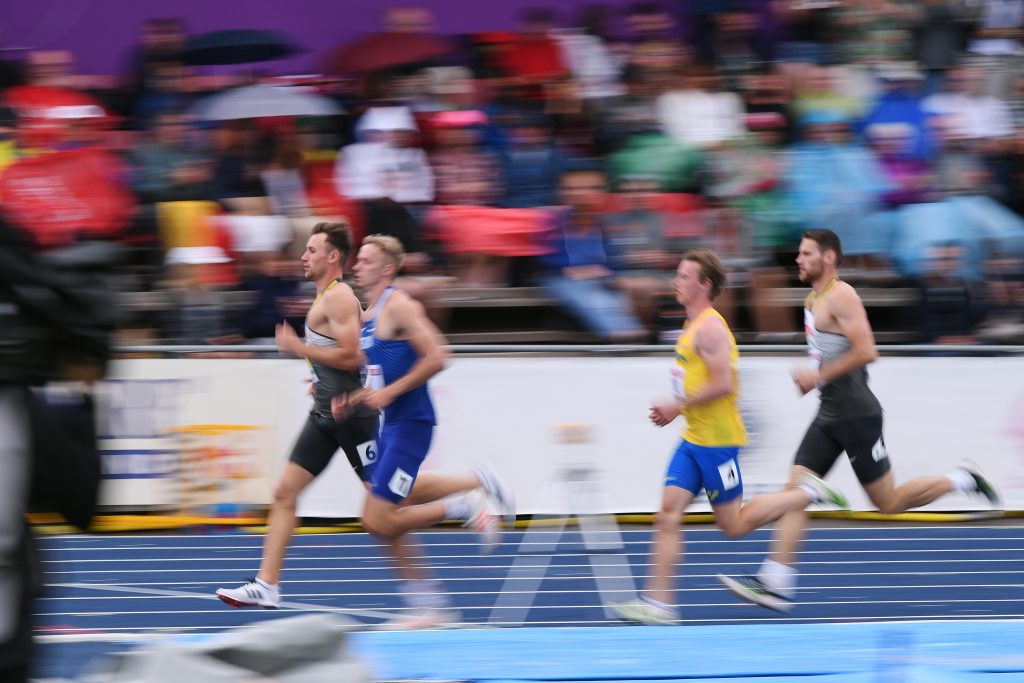
As at the NCAAs, Erm’s approach to what might be possible in Gävle was measured and calculated.
”I was looking at what I’ve done this year, and what can I do. I think I can score about the same [as the NCAAs],” he told me ahead of the meeting. “Some events feel a little better right now, some feel a little worse, but I think I can do about the same. I haven’t really set big expectations because if something goes wrong then I’ll disappoint myself.”
On Day 1 nothing went wrong, and there was no disappointment. “Perfect,” he described it in the mixed zone afterwards, in his characteristic dry style.
A 100m PB of 10.73, a monster long jump just 1cm short of his 7.98m best, a high jump PB of 2.03 and rounding off the day in the 400m just one-hundredth of a second short of his NCAA 400 time. While his new HJ mark brought the most satisfaction that day, he acknowledged his 100m run as something special.
“I knew how to run fast, but I just haven’t had a good start in 2 years, and today was the day. The wind was good, and I think those have been the best conditions in the 100 I’ve ever had.”
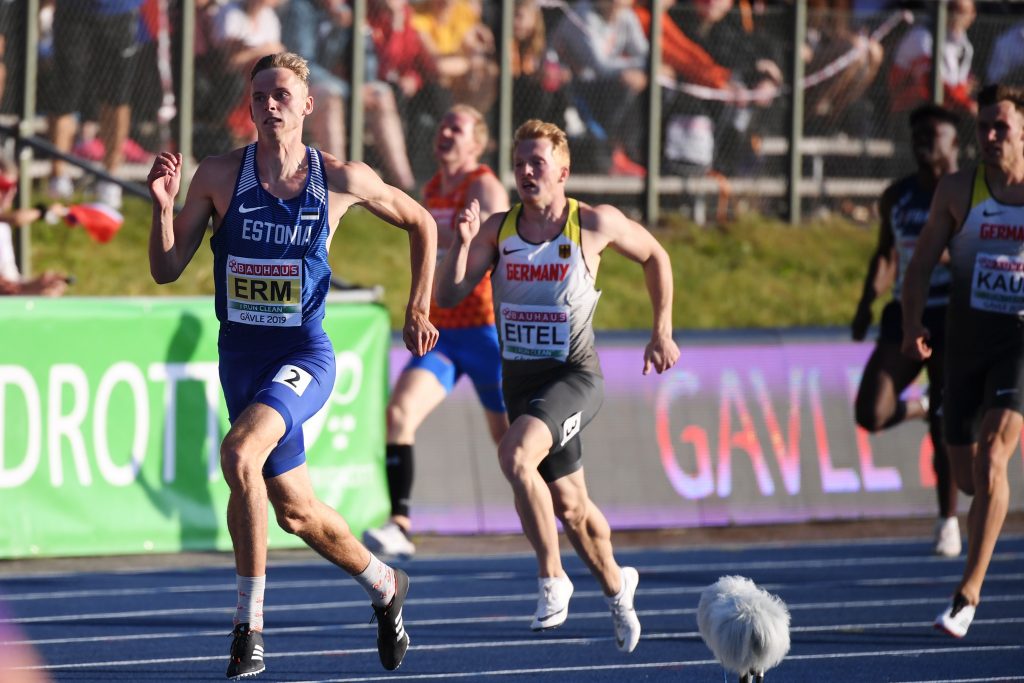
Erm continued to build up a buffer to Kaul’s inevitable Day 2 charge, but the turning point of the competition was the pole vault. Erm cleared only 4.70, allowing Kaul to make up ground in one of his own weaker events. Others might have surrendered and admitted defeat, but an extraordinary javelin competition followed. The headlines were filled with Kaul’s 5m improvement to 77m, but Erm also delivered a 3m improvement on his 56.27 NCAA throw, going out to 58.73, and then responding again with 59.60m to limit Kaul’s advantage to just 17 points going into the final event. Johannes eventually finished in silver with 8445, his second Olympic qualifying mark of the year, and the German credited Erm with pushing him to the gold medal and an Olympic mark of 8572.
“If Johannes weren’t here and scored that well on Day 1, I don’t think I would have done that well,” said Kaul. “Every time he jumps the next height or did a good throw I think – maybe I have to get the next height.”
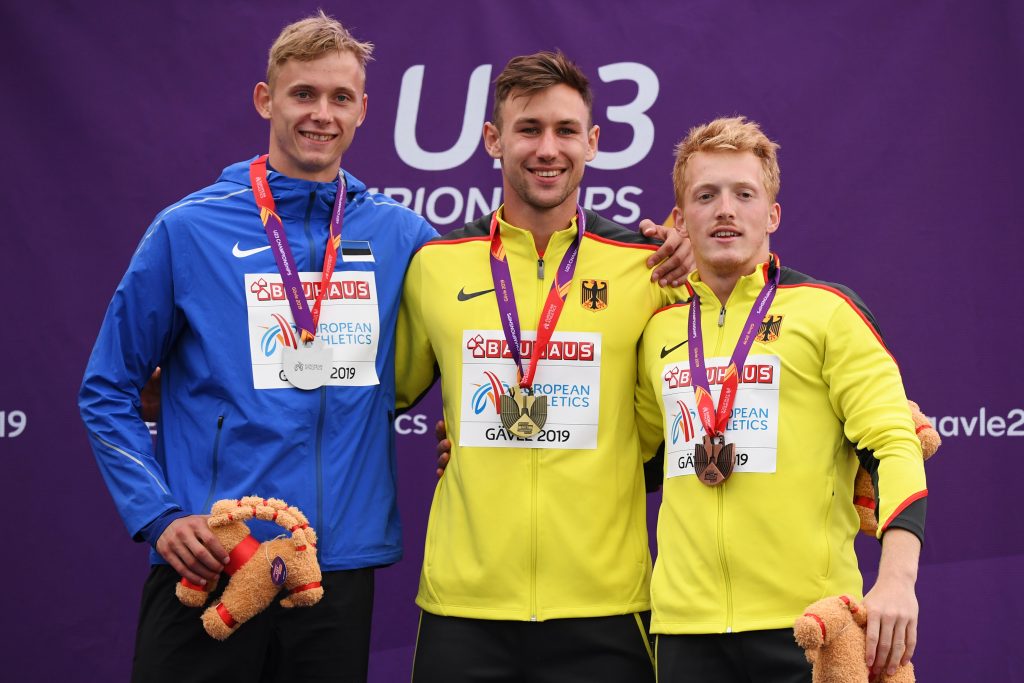
(Photo by Oliver Hardt/Getty Images for European Athletics)
While their next battle might well come at the Olympics, Erm and Kaul are no strangers to competing against each other and sharing the podium. Johannes took the bronze medal at the World Under 20 Championship in Bydgoszcz in 2016, and then silver in 2017 at the European Under 20s in Grosseto (Niklas won both). But Erm originally started out in a different event.
“I used to do triple jump” – his best is 15.19 indoors – “but that injured me. I qualified for the World U18 Championships in triple jump, but I was injured so I didn’t get to go.
When it comes to staying healthy and fresh for championships, the NCAA system can be notoriously relentless for many athletes. Erm seems to have found the formula that works for him as a multieventer.
“Indoor we had quite a lot of competitions, but I don’t think the heptathlon is that tiring, at least compared to decathlon. So, it’s doable. But outdoors I skipped many meets, or if I did them I did some lighter events or something I really wanted to do. So, I saved myself for the NCAAs.”
Doubts were expressed as to whether Erm would be able to maintain form after the NCAAs and long college season, and many anticipated that he would arrive in Gävle fatigued.
“I felt tired for like two, two and a half weeks after, and I was afraid I was going to stay tired until now, but I don’t think that’s the case.”
Navigating through the NCAA season is something that Erm does in partnership with his coach Petros Kyprianou. Alongside his mechanical engineering studies, Erm is part of the “Decathlon Academy” at the University of Georgia, which includes fellow Estonians Karl Robert Saluri, Maicel Uibo and 2017 Grosseto bronze medallist Karel Tilga, and US decathletes Garret Scantling, Kyle Garland and 2019 US champion Devon Williams.
“I was training alone for the last year before I went to the States. I felt that I really needed a training group and that’s where I found it. I saw what Petros had done with some people who hadn’t really tried decathlon. He made them into 8000+ decathletes.”
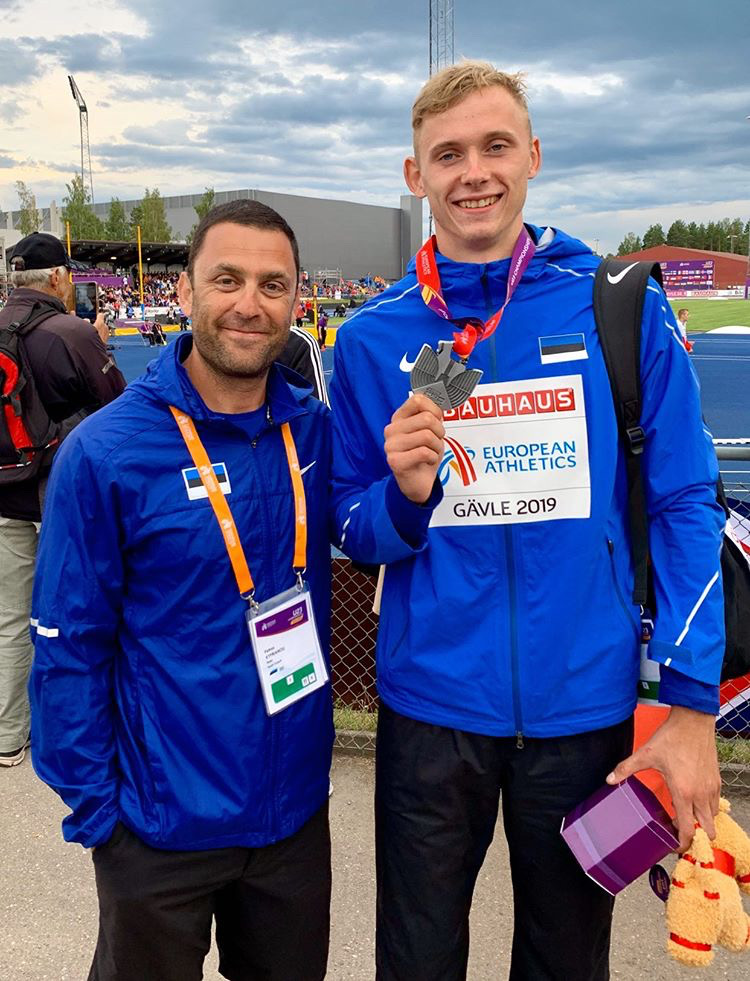
Erm’s decision to pass up the opportunity to compete for global plaudits in Doha was seen by many as bold, and it is quite the achievement to create a buzz about your absence in only your second year in the senior ranks. But in fact, it was all part of a carefully choreographed plan between the canny Estonian and his coach.
Petros is Head Coach for the Georgia Bulldogs in the combined events and jumps, and explains the context for Erm’s approach to decathlon. “We made the decision not to compete in Doha as our main goals were winning the NCAA, with the Olympic standard, and medalling in Gävle”.
“Maybe if Doha was in August we could have tried. But it was his idea and I agreed immediately. Tokyo is the next step in his development.”
“Johannes’ mindset, in my opinion, is his biggest asset. He knows what he wants. He’s not afraid of anything and he knows how to forget fast. That’s what I love about him. Johannes is a very special young man. He’s not just a student of the decathlon, but a very bright student in engineering. He’s known for his unique sense of humour and intelligent demeanour. He also has a very strong sock game and is the proud owner of a vast selection!”
While Erm and Kyprianou seem to have a winning partnership – and a mutual appreciation of footwear – Johannes originally made Petros work pretty hard to bring him to Georgia.
“It wasn’t easy to convince him to come to my team and required me to travel to Estonia numerous times!” says Kyprianou. “Thankfully the development of Maicel Uibo from 7400 to 8500 and our great relationship with the Estonian federation really caught his attention, and he finally accepted my offer. Johannes has a great support system behind him, and I will go with him to the end of the world!”
“Estonians are true lovers of the decathlon, and that matches my love for developing good decathletes. Athens is like a mini-Estonia, not just because of the 4 Estonians, but also the “noise” they create around decathlon, and the push that they have given to my American decathletes.”
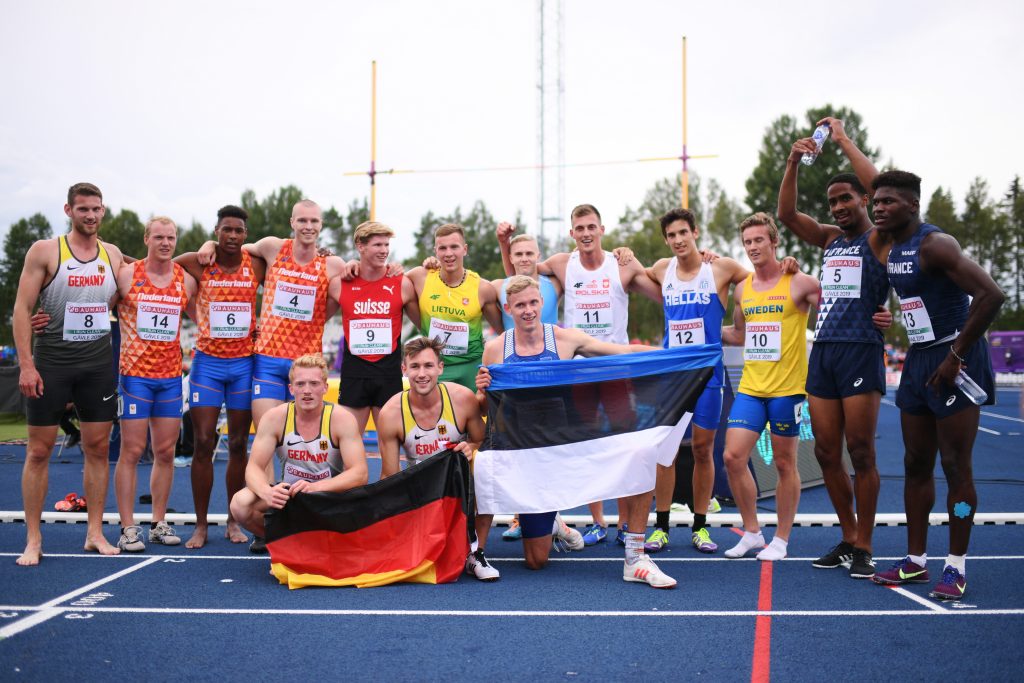
While Johannes was undertaking his final few days of preparation in Sweden, Petros was making his way north from Monaco where two of his other charges, Commonwealth high jump champion Levern Spencer and Olympic triple jumper Keturah Orji had been competing at the Diamond League. In his absence, the greatest Estonian decathlete of them all – for the time being anyway – Erki Nool was part of the support team for Johannes and the rest of the young Estonian squad.
“When I’m practicing he’s giving me notes on what to do, what to change,” Johannes said of Nool in Gävle. “I really respect him, and he’s helpful. As a kid I really, really looked up to him. I still do.”
Erm might look up – metaphorically, if not physically – to Erki Nool, but the Nool legacy is driving a new generation of Estonian athletes to greater achievements. The charge towards Nool’s Estonian record of 8815 and his suite of global and European medals is being led by Uibo, with Erm and Õiglane close behind, and Saluri, Tilga, Kristjan Rosenberg, Risto Lillemets and Taavi Tšernjavski also challenging for precious team places. Erm’s performance in Gävle moved him to fifth on the Estonian all-time list behind Nool, Uibo, Kristjan Rahn and Valter Külvet.
There’s a strong sense of camaraderie and an even stronger delight in the art of the piss-take in the Estonian squad. Erm’s nickname is Spaghetti “Maicel started calling me Spaghetti, and now everyone does it”. Apparently, it’s to do with the socks, rather than his 1.97m frame. Everyone also has their own story about why such a small country can produce so many 8000+ decathletes.
“I don’t know about everyone else, but when I was 12 and went to track and field practice, we started doing everything. Maybe I never decided what I’m good at, so I stuck with decathlon”, Erm shrugs.
The presence of the Olympics in the 2020 calendar will mean different things to different decathletes.
For some, Tokyo will be the inspiration to strive for a future Games, perhaps Paris in 2024 or Los Angeles in 2028. For some, securing enough points from the new world rankings system to earn an invitation to Tokyo will be the challenge. Others – including the current world record holder – will be pursuing an outright qualification score of 8350 by 29 June 2020, to join the eight men already qualified.
And for Johannes Erm, NCAA champion, European Under 23 silver medallist and Mr Spaghetti 2019, the challenge will be to continue the intelligent preparation and execution – whether that be in choice of hosiery or in the pursuit of decathlon excellence – that we’ve had the pleasure of witnessing this year.

